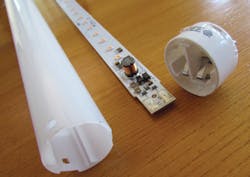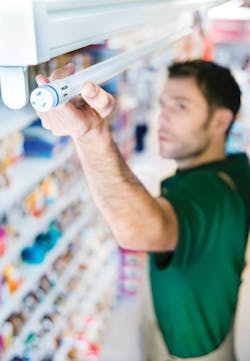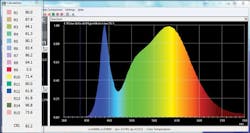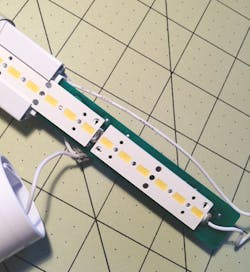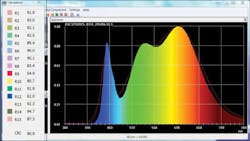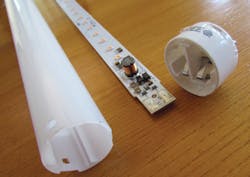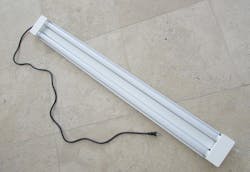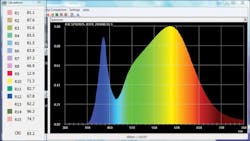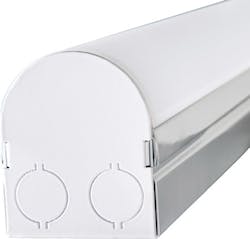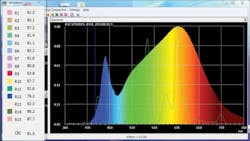MARGERY CONNER tests affordable LED-based fluorescent alternatives, identifying the strong points in product design, vulnerabilities that may impact reliability, and suitability for applications.
Fluorescent lighting is the largest consumer of electricity in the US, making it an enticing target for LED lighting manufacturers. However, unlike incandescent bulbs, which were an easy target for LEDs because of the bulb's excessive use of power, modern T8 fluorescent lamps are relatively efficient power users. Still, as a hands-on evaluation will document, there are good reasons for commercial and residential users to consider solid-state lighting (SSL) alternatives to fluorescent products, and hands-on testing reveals such opportunities along with insight into different LED-based product designs.
Indeed, there is still a large installed base of power-wasting T12 lamps and inefficient T8s both in the US and around the globe. As of July 14, 2014, fluorescent lamps that can't meet efficacy levels of 88 lm/W, or 89 lm/W for lamps with CCT greater than 4500K, are no longer allowed to be manufactured or imported into the US. This eliminates all T12 fluorescent lamps and many T8s.
LED lighting manufacturers, established brands as well as relative newcomers, are jumping in to fill the coming void. I say "coming" because as of Spring 2015, you can still easily find T12s on the shelves of, for example, Target and Home Depot. Retailers are permitted to sell out their inventory.
Tubes mature, add value
While LED versions of the familiar T8 lamps have been available for some time now, it's only recently that they've improved in both performance and price to the point that they are credible alternatives to fluorescent lighting. And LEDs can bring other advantages. LED-based tubes can deliver better color quality for demanding commercial and retail settings (Fig. 1). In addition to potential power savings, LED T8 lamps can also respond to intelligent controllers, for even more energy savings. This "smart lighting" is behind the move to replace fluorescents with LEDs in the commercial/industrial space.
In the residential space, fluorescents are often used in cold environments, such as garages, workshops, and barns, where fluorescents turn on sluggishly and often flicker in the cold. LEDs can turn on instantly, and cold doesn't affect their performance. In addition, a high-CRI, dimmable LED tube lamp can make a noticeable difference in kitchen, game room, or bathroom lighting, with no audible hum or flickering. There are an impressive number of lamps and lights available now. What follows are details from hands-on evaluations of a selection of tubes and fixtures that are readily available and look promising.
Retrofit versus replacement
There are two different approaches for migrating existing fluorescent lighting installations to LEDs: replacement lamps, and retrofit lamps or fixtures. LEDs Magazine regularly uses the "retrofit" and "replacement" descriptors interchangeable to imply products sold for upgrade of fixtures that use legacy fluorescent or incandescent lamps. But here we will make a subtle distinction.
Replacement lamps are just what the name says - they are a direct replacement for a fluorescent lamp in an existing unmodified fixture: You pull out the old fluorescent lamp from the fixture, and in goes the LED lamp. This seems like an ideal solution, but its drawback is that the lamp must work with the fixture's existing ballast, incurring the penalty of the extra ballast. A feature article from last year contemplated the benefits from such designs while just last issue (April/May) the magazine ran a feature that defined the varying approaches to LED tubes.
As discussed in the above links, it's a significant product-development challenge for the tube manufacturer to design an LED lamp driver that has to be able to accept input from a wide variety of existing fluorescent ballasts from different manufacturers. And fluorescent ballasts generally have a shorter lifespan than LED lamps that can compromise the advantages of tube replacements.
Retrofit T8 lamps require that the fixture be modified for tube installation. Typically, the retrofit requires removal of the ballast, allowing direct wiring between the lamp and the AC power coming into the fixture. The obvious disadvantage of the retrofit option is that it requires the cost, effort, and knowledge to rewire the fixture. The advantage is that the retrofitted fixture pays no efficiency penalty since it only has its own lamp driver.
Other LED linear lighting options are workshop lights and completely new fixtures that don't rely on replaceable lamps. The table summarizes the specifications for the seven different lights that I evaluated, all 48-in. alternatives to T8 or T12 fluorescent lighting.
Hyperikon
The Hyperikon lamp is a retrofit-type lamp, which requires that you have the fluorescent fixture rewired with removal of the original ballast. The light is direct-wired into the building's AC power. Fig. 2 depicts the spectral power distribution (SPD) as measured with an MK350 spectrometer and MoreSpectra software from Moreland Lighting (morelandlighting.com).
The lamp has a respectable CRI of 82 at 1980 lm and a CCT of 4000K. The light's chief advantage is its excellent price. At $19 per lamp, it's the lowest-priced LED lamp of the ones I evaluated.
However, for me its Achilles heel is that there is a perceptible delay in its turn-on. This is a deal breaker for me, but for those who expect to turn the light on and leave it on in a shop or factory environment, this might not be so critical. Read more: http://bit.ly/1AmaklT.
Specifications for lights under evaluation - 48-in. alternatives to T8/T12 fluorescents.
Hollywood Lights
The Hollywood Lights (HL) is another retrofit lamp (Fig. 3). The HL's light numbers are very good with CRI of around 90 and luminous flux output of 1900 lm per lamp. Moreover, let's consider more details of the actual light characteristics by comparing the SPD of the HL product relative to a Cree product that we will discuss a bit later (Fig. 4).
I've taken advantage of the MoreSpectra software's ability to overlay one light's SPD on another. Look at Fig. 4 for the HL lights and you'll see a red line superimposed. The red line represents the SPD for the Cree LS series, which is a new designed-from-the-ground-up linear LED fixture with excellent CRI.
As you can see from the red line, the blue spectrum is less strong and peaks at a shorter wavelength in the case of the Cree product. We can see that the HL has excellent color quality - comparable to the Cree LS Series - but at a fraction of the price.
In addition, the HL has a unique feature for an LED tube retrofit lamp in that it is compatible with legacy, triac, phase-controlled dimmer switches. Since I discovered just how expensive it is to add the control equipment for 0-10V dimming of LED lights when researching the Cree LS series dimmability (http://bit.ly/1IszbLI), I have a newfound respect for the simplicity of dimming with triacs. I used to think triacs were electrically noisy and a crude way to dim a light, but I now understand the advantage of not having to string a separate line for dimming control information.
Now let's take a look at what's inside the HLs - some of which is evident in Fig. 3. These LEDs are not the usual discrete LEDs mounted on a single long, thin printed-circuit board (PCB). Instead, the HL's internal LEDs come six to a module, where each module is a combination leadframe and heat sink. Hollywood Lights has applied for a patent on this, and calls it chip-on-lead-frame/heat sink (CoLH). The advantage of this approach is that the LEDs are in much closer contact with the heat sink, allowing them to dissipate more heat and yield greater efficacy (lumens per watt, lm/W).
In addition, modules make for a more reliable packaging design, since there are fewer discrete LED components to be assembled, and each additional component in a design generally increases the potential for failure. Modularization of the LEDs also makes for easy, automated assembly as well as repairability and even upgrading of the lamps, something that's to be applauded in our throw-away culture. The combination of excellent dimming, high CRI, and reasonable price makes the Hollywood Lights an excellent choice for replacing your T8 fluorescents. Of the LED T8 lamps I've tested so far, it's my favorite. Read more: http://bit.ly/1DFbdGq.
Philips InstantFit
Next up, the Philips Lighting InstantFit T8 was introduced last year and is one of two replacement lamps that I examined. According to Todd Manegold, director of LED lamps marketing at Philips, 80% of existing fluorescent ballasts are electronic instant-start ballasts, over 10% are rapid start, and less than 5% are dimming ballasts. Philips went for compatibility with the large installed base of non-dimming instant-start ballasts in the InstantFit development.
The InstantFit also targets fluorescent lights that must work in cold temperatures, as low as -22°F (-30°C). The light has a rated average life of 50,000 hours, which no fluorescent lamp can even approach at cold temperatures. My SPD test revealed that the InstantFit products deliver quality light with a CRI of 83.
The Philips lamps have relatively high efficacy, but the total flux produced is still only 1600 lm - the lowest of any of the lights I checked out. We'll cover differences we can expect to see in LED tube lamp lumens compared to fluorescent tube lumens later in the article because the flux figure isn't necessarily bad news. Read more: http://bit.ly/1FAESqa.
Cree LED TW series T8 LED
Like the Philips InstantFit, the Cree LED TW Series T8 is a replacement lamp that works with existing fluorescent fixtures that have their ballast still intact. This is a new lamp, not to be confused with Cree's original T8 replacement lamp that the company introduced a year ago, which will no longer be sold.
The new product is a round tube, unlike its predecessor's elliptical tube, which also had a solid aluminum heat sink along the back. The new version is all plastic and is opaque on the side that's along the fixture. I tested 2700K- and 4000K-CCT versions of the product and each delivers excellent light quality. As you can tell from the two SPD graphs, the light quality is excellent for both color temperatures. Fig. 5 depicts the SPD of the 2700K version.
I've again used the overlay capability with the MoreSpectra software to highlight the differences in the SPDs of the two Cree products - the green line in Fig. 5 is the outline of the 4000K light. As you can see, the blue is much less pronounced in the 2700K light, yet the R12 (blue) number is actually higher than the 4000K version, and the 2700K light has a slightly higher CRI of 91 - which I wouldn't have expected if looking only at the SPD, and which points out the value of being able to see the individual R values to understand all of the light's spectrum.
The Cree lamp's luminous flux is specified as 1700 lm. Now is a good time to look at the difference in lumen output quoted for fluorescent lamps versus LED T8 lamps. Lumens characterize all light output by a lamp in a complete spherical pattern. Since fluorescent lamps radiate in a 360° field, you end up with high number of lumens, even though for most fixtures the light emitted from the top (fixture-side) of the lamp must first bounce off of the fixture before it makes its way down to the surface we actually want illuminated, with optical losses inherent in the design.
LED lamps, being made up of directional LED components, don't waste light by bouncing it up toward the ceiling but direct almost all of it downward. This is why, even though fluorescents tube lights quote a higher number of lumens, LED tube lights can deliver more usable light to the work surface.
So what's inside the new Cree lamp (Fig. 6)? The most obvious external change is that the new lamp doesn't have the aluminum heat sink backbone from the prior Cree design - clearly a significant cost savings. The new lamp's external package is an all-encompassing plastic tube. The electronic components are all discrete components with no power management IC. And the number of LEDs themselves has dropped from 120 in the old version down to 80 in this newer model.
It's also noteworthy to discuss the LEDs used in the new Cree tube. The earlier product used the company's high-power XLamp XH-B LEDs. And Cree has been a staunch proponent of high-power packaged LEDs over mid-power LEDs for general lighting applications. But the LEDs in Fig. 6 are not representative of any lighting-class LEDs in the Cree portfolio. Perhaps the mid-power LEDs came courtesy of the Cree partnership with Lextar announced in August 2014. Moreover, the mid-power packaged LEDs may enable a lower-cost product.
The original Cree T8 had a light output of 2100 lm, and with 120 LEDs the math works out to 17.5 lm/LED, while the new lamp's 1700 lm and 80 LEDs works out to 21 lm/LED. The new product has a drop in total lumen output but a 21% increase in lm/LED over the original version. Cree apparently believes the market will accept a lower-rated lumen output for the lamps, and, combining it with the increased output per LED, it's able to drop the number of LEDs per lamp.
While Cree specifies the new lamp to have a system power draw of "as little as 18.5W," the ballast I used, a very common Philips Advance, showed a total fixture power draw of almost 49W, or 25 W/lamp. This relatively high power consumption is because of the legacy ballast in the fluorescent fixture. I asked Cree what ballast they used in their test to get the 18.5W number. The company had not responded to me by press time. Since LEDs are associated in most consumers' minds with power efficiency, it may come as a surprise that - at least in the fixture/ballast combination I used - the Cree is less power efficient than a high-efficiency fluorescent light.
Why would anyone want to replace their efficient fluorescent lamps with less- efficient LED lamps? If you're a homeowner with fluorescent lights in a kitchen or bathroom, the excellent light quality of these lamps makes them a strong contender with a high-CRI, wide color spectrum that can't be approached by fluorescent competitors. And if you are looking at these for a retail establishment, where your customers will be much happier when they don't look like the Crypt-Keeper in shades of cool blue and green, these will be a hit, as well as saving you time and money in tube replacement costs. Read more: http://bit.ly/1JVaxBv.
Feit shop light
The 48-in. Feit shop light (Fig. 7), is, as far as I know, sold only by Costco. A shop light is different from a typical fluorescent fixture in that, rather than being hardwired into the building power, it has its own power cord that plugs into a wall outlet. Shop lights are a good candidate for LED lighting: You get away from the need to mess with the building wiring as you do in in a retrofit light, but you aren't stuck with legacy fluorescent ballasts the way you are with replacement LED T8 tube lights. The Feit doesn't have to support a seemingly endless array of ballasts the way the Philips InstantFit or Cree TW T8 do.
The Feit shop light sells for a very reasonable $38 and produces 3700 lm of 83-CRI light while consuming 38W. This compares favorably to the equivalent of two T8 fluorescent lamps. While at first glance it looks like the light has two replaceable tube lamps, they are actually integral to the fixture and can't be replaced. Some consumers seem confused by the lack of replaceable lamps based on comments on the Costco website. But Feit presumably maintained the lamp-like look for consumer familiarity.
When I turned the Feit light on, there was a faint hum when I put my ear right up next to the light, but it quickly fades and becomes inaudible when the light is suspended from the ceiling. The light itself is more than acceptable for garage and workshop lighting, as you can see in the SPD graph (Fig. 8).
The R9 (red) CRI of 12 may not seem very high until you consider that fluorescent shop lights often have a negative R9 value. At the other end of the spectrum, the R12 (blue) is a respectable 67. The overall CRI of 83 is a heck of a lot better than what you may currently be getting from your fluorescent shop lights. So in terms of light quality, the Feit shop light performs well.
Let's see what's inside: As I mentioned before, the Feit doesn't have replaceable tube lamps. This is actually a good design decision. By making the tubes integral to the fixture, Feit can take advantage of the long life of LEDs. There's no need to make a part replaceable when it's no longer the weakest link. Each tube contains a long, skinny metal-core PCB with 60 mid-power packaged LEDs.
The Feit fixture makes use of connectors, rather than hand-soldering, to attach the driver electronics to the LED PCB, which is generally a more reliable approach.
The LEDs are conventionally mounted on the PCB in contrast to the LED module approach used in the Hollywood Lights T8 LED retrofit lights shown previously. The Hollywood Lights approach is a more reliable, manufacturing-friendly one, while the Feit design is generally a lower-cost approach. But the Feit is, after all, an inexpensive shop light, while the HL light is a high-CRI dimmable indoor light. Both approaches are appropriate for their application. Read more: http://bit.ly/1GJEggt.
Cree LS Series Surface Ambient
The last fixture we cover in this article, while a linear LED light, is not a replacement or retrofit for an existing fluorescent fixture but an entirely new linear light - the Cree LS Series (Fig. 9) Surface Ambient. The light produces 4000 lm with a CRI of 92 and is dimmable with 0-10V dimming.
As you can see in the photo, the light fixture itself is quite narrow, but it still produces an equivalent amount of light to a much wider two-lamp fluorescent fixture. The light source and fixture are integral with no lamp to replace and collect dust, and no separate light diffuser, making this a no-maintenance light. In addition, it comes with a 10-year warranty, a big plus for any new lighting product.
I won't be showing an under-the-hood photo of the LED source as I'd have to break open the module, and Cree is very clear that this will void the warranty. I paid $127 for this light - which is too much to trash!
My subjective view of the light quality of the 3500K version was that it looked great, especially good for skin tones; as this light replaced an obsolete T12 fixture in a bathroom, excellent light quality was important. But the real proof is the spectrometer reading shown in Fig. 10.
It verified Cree's claimed high CRI at 91. But a more in-depth understanding of the light is gained from the R values. The R9 (red) is a healthy 53 and the R12 (blue) is a 79 - much better than the fluorescents, and telling the whole story better than the CRI alone. In addition, I've overlaid an SPD of a fluorescent lamp in green to drive home the dramatic improvement in light we see with a high-end LED light. Read more: http://bit.ly/1IszbLI.
It's clear at this point in the LED technology evolution that SSL products can effectively replace fluorescent technology. In some cases, the SSL alternative can offer additional energy savings - and, in most cases, improved light quality when consumers choose products carefully.
MARGERY CONNER is the editor of the Designing with LEDs (designingwithleds.com) website.
